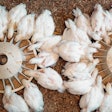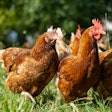The majority of poultry and pigs are fed diets based on wheat, barley and corn. Other cereals imported or locally produced usually are cost prohibitive or simply unknown. Quite often, minor cereals, such as rye can be available at competitive prices or is the only cereal available locally.
In such cases, the major concern is the presence of certain anti-nutritional factors that could impair animal performance. To this end, using enzymes and having upper limits of inclusion for feed formulation purposes are required to ensure proper feeding of farm animals.
Pentosans and enzymes
Rye can be considered the “poor relative” of wheat. It grows under similar conditions, but can withstand much harsher climates and relative infertile soils. As such, rye contains higher levels of anti-nutritional factors compared to wheat. Rye is a rich source of soluble non-starch polysaccharides, and particularly pentosans (arabinoxylans). These polysaccharides resemble hemicellulose in nature.
When pentosans reach the small intestine, they tend to produce a viscous environment that reduces nutrient digestibility. They also tend to produce soft and sticky feces, a problem particularly of high concern for broilers and layers. Adding a suitable enzyme in the diet almost always helps reduce these negative effects of pentosans in rye (and in some degree in wheat). In fact, Canadian research has demonstrated that feeding good quality rye along with an enzyme, produces results similar to feeding a diet based exclusively on barley.
Ergot and rye
The issue of rye quality has to do with the presence of a toxin produced in the field by a fungi called ergot. Ergot infested rye contains toxic alkaloids, including ergotamine, ergotoxine and ergonovine-among more than 10 toxic compounds. Ergot toxins reduce animal feed intake, growth and severely impair reproductive performance. To combat the problem of ergot infestation, new varieties of rye have been developed with genes that confer additional resistance to these toxic fungi. But, it is always best to assume this problem might be present and employ suitable quality control measures to ensure the rye is ergot free.
Feeding levels
When good quality rye is available and a suitable enzyme has been identified, rye can be fed to growing-finishing pigs and gestating sows. When quality is suspicious or without an enzyme, it is best to limit rye inclusion level to 25 percent. Rye should not be fed to lactating sows and piglets because as an ingredient it is rather unpalatable and reduces feed intake, even without ergot toxins. For poultry, rye can be used up to 20 percent in layer diets, and at no more than 10-15 percent in broiler diets, depending on age. Growing pullets can be fed even higher levels, reaching up to 40 percent.
Palatability issues
Palatability issues in rye have been attributed, partially to fine grinding. Coarse grinding, pelleting and adding oil to the feed helps reduce the issue of dustiness in rye, but they don’t solve completely the issue of its unpalatable nature.
It is important to note, that coarse grinding also reduces nutrient digestibility and should be taken into account when formulating diets. Gradual introduction of rye in feeds helps overcome the problem of low palatability, and what really helps is the inclusion of some molasses in the same diet.


















